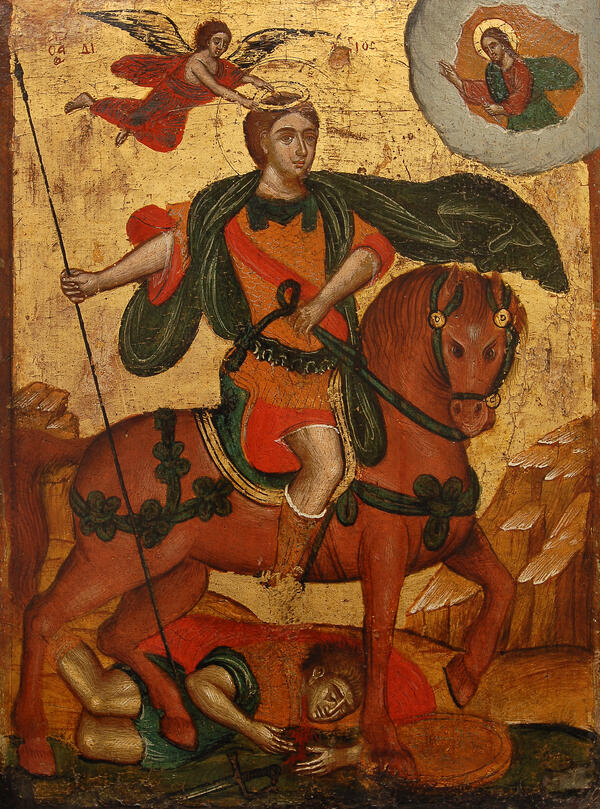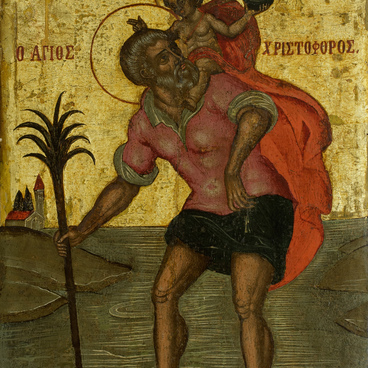The icon “Saint Demetrius of Thessalonica” by an unknown master was transferred to Vladivostok from the Pushkin State Museum of Fine Arts in 1930. Judging by a number of its characteristics, this icon is an example of 16th-century Cretan icon painting.
After the fall of Constantinople in 1453, the traditions of Byzantine art continued to exist over the following centuries in the works of Greek expatriates, many of whom settled in diasporas in Italy. Experts have given a name to this phenomenon — “the Cretan school of icon painting”. The iconographic art of this school is distinguished by its eclecticism: a combination of Byzantine traditions with motifs of contemporary Italian art. In particular, it is characterized by the use of gold hatching (gold leaf strokes on the folds of clothes), as well as a gold background. Among the famous natives of the Cretan school are the icon painter Paolo Veneziano, as well as the artists Marco Basaiti, Vittore Carpaccio, and Cima da Conegliano.
Demetrius of Thessalonica is a Christian saint venerated as a Great Martyr. On the icon from the Primorye State Art Gallery, Demetrius of Thessalonica is depicted on horseback, with a flying angel on the left putting a golden crown of martyrdom on the saint’s head. This is borrowed from an ancient tradition, where the winner defeating the enemy was awarded a diadem by the winged goddess Nike. The lying male figure in the lower part of the icon is related to a plot from the Life of Demetrius of Thessalonica. According to one version, this is the gladiator Lyaeus, and according to another — the Bulgarian tsar Kaloyan.
According to the Life of Demetrius of Thessalonica, a Christian, Nestor by name, a friend and disciple of Saint Demetrius, volunteered to fight Emperor Maximian’s favorite, the gladiator Lyaeus, and killed his opponent. By order of the angry emperor, Nestor was beheaded, and Demetrius was stabbed with spears.
According to another version, this figure appeared in the composition of the icon due to a posthumous miracle, where Demetrius struck down tsar Kaloyan, who was besieging Thessalonica, with a spear. Such compositions became widespread in Byzantine art in the 13th — 14th centuries under the name “The Miracle of Saint Demetrius”.
After the fall of Constantinople in 1453, the traditions of Byzantine art continued to exist over the following centuries in the works of Greek expatriates, many of whom settled in diasporas in Italy. Experts have given a name to this phenomenon — “the Cretan school of icon painting”. The iconographic art of this school is distinguished by its eclecticism: a combination of Byzantine traditions with motifs of contemporary Italian art. In particular, it is characterized by the use of gold hatching (gold leaf strokes on the folds of clothes), as well as a gold background. Among the famous natives of the Cretan school are the icon painter Paolo Veneziano, as well as the artists Marco Basaiti, Vittore Carpaccio, and Cima da Conegliano.
Demetrius of Thessalonica is a Christian saint venerated as a Great Martyr. On the icon from the Primorye State Art Gallery, Demetrius of Thessalonica is depicted on horseback, with a flying angel on the left putting a golden crown of martyrdom on the saint’s head. This is borrowed from an ancient tradition, where the winner defeating the enemy was awarded a diadem by the winged goddess Nike. The lying male figure in the lower part of the icon is related to a plot from the Life of Demetrius of Thessalonica. According to one version, this is the gladiator Lyaeus, and according to another — the Bulgarian tsar Kaloyan.
According to the Life of Demetrius of Thessalonica, a Christian, Nestor by name, a friend and disciple of Saint Demetrius, volunteered to fight Emperor Maximian’s favorite, the gladiator Lyaeus, and killed his opponent. By order of the angry emperor, Nestor was beheaded, and Demetrius was stabbed with spears.
According to another version, this figure appeared in the composition of the icon due to a posthumous miracle, where Demetrius struck down tsar Kaloyan, who was besieging Thessalonica, with a spear. Such compositions became widespread in Byzantine art in the 13th — 14th centuries under the name “The Miracle of Saint Demetrius”.



